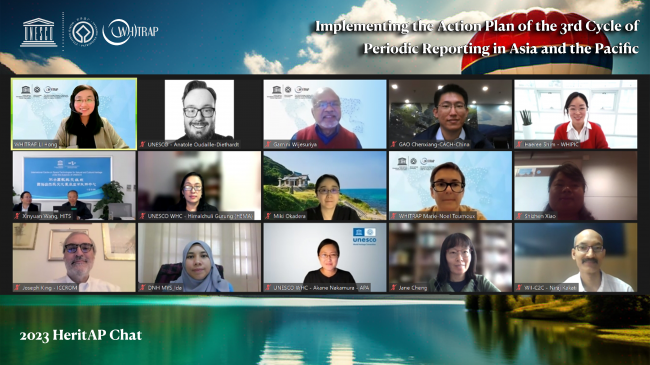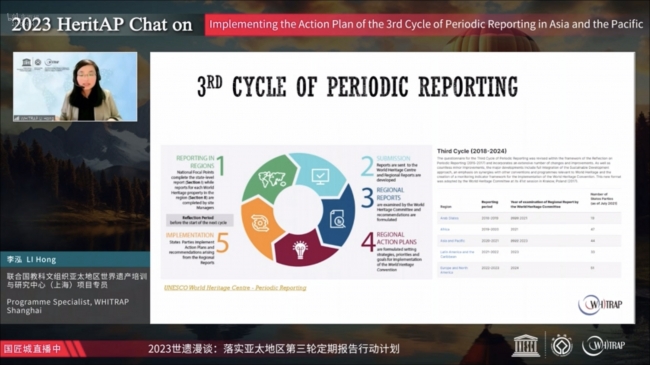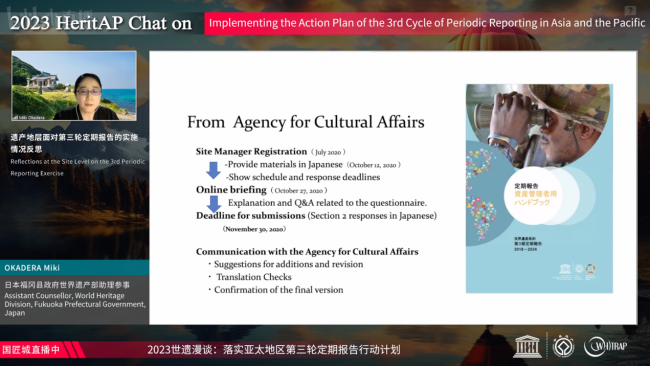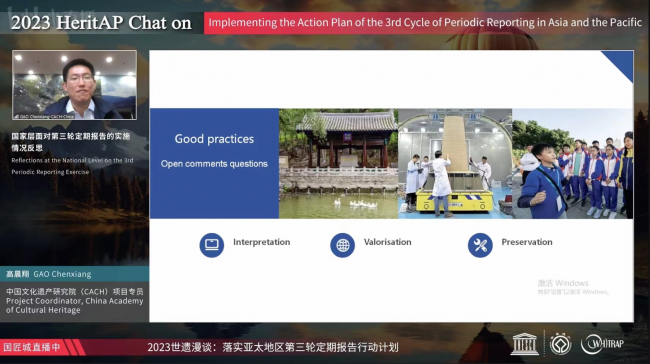| 2023 HeritAP Chat on Implementing the Action Plan of the 3rd Cycle of Periodic Reporting in Asia and the Pacific |
| PublishDate:2023-10-31 Hits:3563 |
On October 18, the 5th Heritage Asia and the Pacific (HeritAP) Chat on “Implementing the Action Plan of the 3rd Cycle of Periodic Reporting in Asia and the Pacific” was held online. The Chat was organized by the World Heritage Institute of Training and Research for the Asia and the Pacific Region under the auspices of UNESCO, Shanghai Center (WHITRAP Shanghai). Ten experts, including representatives from the World Heritage Centre, International Centre for the Study of the Preservation and Restoration of Cultural Property (ICCROM), Category 2 Centres in the Asia and the Pacific region, countries and sites involved in the 3rd Cycle of Periodic Reporting, participated in the chat. The event consisted of themed presentations and free chat, reviewing the 3rd Cycle of Periodic Reporting and introducing the Regional Framework Action Plan that was endorsed at the extended 45th session of World Heritage Committee. The chat focused on the steps for implementing the Action Plan with Category 2 Centres playing a central role. In total 24 HeritAP members attended the ZOOM Meeting and about 1053 viewers watched the live stream.  Event cover
 Online group photo
At the beginning, Ms. LI Hong (Programme Specialist, WHITRAP Shanghai) gave an introduction to HeritAP and the 5th HeritAP Chat. Periodic Reporting is one of the core monitoring mechanisms of the World Heritage Convention. The 3rd Cycle of Periodic Reporting in Asia and the Pacific was completed in 2021, involving 44 States Parties and 269 World Heritage properties. The 5th HeritAP Chat would reflect on the exercises, promote the regional framework of the Action Plan and draw the road map of implementing the Action Plan in the following years, especially the role of WHITRAP and the other agencies namely WHC, Advisory Bodies (ICCROM, ICOMOS and IUCN) and C2Cs in APA.
 Ms. LI Hong presenting
In the first session, four experts reviewed the exercise, outcome and action plan of the 3rd Cycle of Periodic Reporting in Asia and the Pacific region.
Ms. Himalchuli GURUNG (Chief of the Asia and the Pacific Unit, UNESCO WHC) made an introduction to the Action Plan of the 3rd Cycle of Periodic Reporting. Periodic reporting provides a comprehensive assessment of the implementation of the Convention at both the national and the property site levels. The Regional Framework Action Plan, Ms. Himalchuli GURUNG highlighted, is the culmination of collaborative efforts and thoughtful consultation that occurred as part of the 3rd Cycle of Periodic Reporting in the region. It is a key guiding document for World Heritage in the Asian Pacific region for the next six years or more. The plan is based on the five strategic objectives of the World Heritage Convention: credibility, conservation, capacity building, communications, and communities. She also emphasized that UNESCO field offices and Category 2 Centres under the auspices of UNESCO have been placed at the core of the implementation of this Action Plan. Finally, she went through the main expected results of the Action Plan following its structure by strategic objectives of the committee. The completed Action Plan can be downloaded at: https://whc.unesco.org/archive/2023/whc-23-45com-10A-en.pdf.
 Ms. Himalchuli GURUNG presenting
Mr. Joseph KING (Senior Director, Office of the Director General, ICCROM) delivered a presentation on “Connecting the World Heritage Capacity Building Strategy with the 3rd Cycle of Periodic Reporting”. He commenced by the development of the Capacity Building Strategy. Although it is not on the same timeline as Periodic Reporting cycles, it supports the implementation of Action Plan worldwide. He then pointed out that while significant achievements had been made in the second World Heritage Capacity Building Strategy, there were areas requiring improvement. Key observations included the necessity of engaging high-level officials and politicians, a demand for more precise targeting of efforts, better coordination and strategic planning for capacity building and an appeal for more stable funding to facilitate the dissemination of knowledge and skills. Additionally, it was stressed that national-level strategies should be tailored to the unique needs and situations of individual countries, fostering a more robust and adaptable approach to capacity building.
 Mr. Joseph KING presenting
Ms. OKADERA Miki (Assistant Counsellor, World Heritage Division, Fukuoka Prefectural Government) made some reflections on the 3rd Periodic Reporting Exercise based on her experiences as the site manager of Japanese World Heritage Site, the Sacred Island of Okinoshima and Associated Sites in the Munakata Region. Firstly, she introduced the online trainings of the 3rd Periodic Reporting to the State Parties, which then promoted to site managers within Japan. She then talked about the difficulty at the site level. Differences between existing monitoring system and questionnaire of 3rd cycle Periodic Reporting required enormous adaption at site level with short schedule. Finally, she prospected the way forward by introducing the actions they are going to take. She asserted they would focus on updating the HIA system based on the 2022 Guidance and Toolkits for Impact Assessments in a World Heritage Context.
 Ms. OKADERA Miki presenting
Mr. GAO Chenxiang (Project Coordinator, China Academy of Cultural Heritage) focused on reflections at the national level on the 3rd Periodic Reporting Exercise. The questionnaires for the periodic reporting exercise were divided into two parts, filled out by the National Cultural Heritage Administration, the National Forestry and Grassland Administration, and 55 National Focal Points in China. The China Academy of Cultural Heritage provided consultancy services to the National Focal Points and site managers and developed a monitoring and early warning platform for World Cultural Heritage sites in China. The results showed that site managers were aware of their property boundaries and found them efficient for preserving the Outstanding Universal Value. While the Capacity Building Strategy was well implemented at national level, some World Heritage sites did not have their own strategy. Therefore, Chinese government has initiated a National Action Plan for World Cultural Heritage for the next six years, mainly covering three objectives: contribute to a representative and balanced World Heritage list, strengthen preservation and management capacity and integrate sustainable development perspectives.
 Mr. GAO Chenxiang presenting
Ms. Haeree SHIM (Head of Education and Networking Office, International Centre for the Interpretation and Presentation of World Heritage Sites) raised two questions towards Ms. Himalchuli GURUNG and Mr. Joseph KING respectively. She first asked Ms. Himalchuli GURUNG though 34 certain actions had been listed, how to deal with the other actions that are urgent but have not been properly covered. Ms. Himalchuli GURUNG pointed out that the action plan is a framework which is the outcome of the questionnaire. The bottom-up approach is welcomed while implementing the action plan. How to engage community into participation is also significant.
Then Mr. Joseph KING answered Ms. Haeree SHIM’s puzzle on whether we should shift the focus of capacity building to decision makers. He reemphasized that capacity building targeting practitioners, professionals, communities and others continues, while we also need to design the capacity building to decision makers.
In the second session, participants had a discussion around the questions “According to the Action Plan (2023-2030) for the Asia and the Pacific region, HOW can your organization contribute to implementing it? Out of the 34 actions/ activities what are the ones you would like to highlight?” Mr. Gamini WIJESURIYA (Special Advisor, WHITRAP Shanghai) moderated the free chat. Representatives from Category 2 Centres shared their opinions.
Mr. Niraj KAKATI (Technical Officer, Wildlife Institute of India - Category 2 Centre for World Natural Heritage Management and Training for Asia and the Pacific Region) emphasized the importance of reviewing tentative lists and enhancing collaboration and synergies among different Biodiversity-related Conventions within the World Heritage framework. He highlighted the significance of improving monitoring and self-evaluation by organizing regular meetings for National Focal Points and site managers and facilitating mid-cycle reporting to maintain consistency in heritage site management. He also appealed to enhance awareness among diverse stakeholders, with a special focus on youth and women. These preliminary actions align with their ongoing activities, fostering collaboration between conventions at the national level. WII-C2C has been proactive in heritage professional training, offering master’s and certificate courses in heritage management. They plan to expand this training to developing countries in Latin America, the Caribbean, and Asia. Additionally, WII-C2C consistently raises awareness of World Heritage through online programs and events, promoting a coordinated approach in collaboration with the World Heritage Center, advisory bodies, and other Category 2 Centers.
Mr. WANG Xinyuan (Deputy Director, International Centre on Space Technologies for Natural and Cultural Heritage) introduced HIST as the formal operation began in July 2011, and its mission is to make full use of space technology for nature and cultural heritage, and assist UNESCO’s program and member states. He indicated that capacity building is important in implementing the 3rd Cycle Action Plan. He gave some suggestions on the 3rd Cycle Action Plan. First, we should strengthen monitoring land cover changes in World Heritage sites. Second, the assessment should focus on OUV. Third, we should integrate nature and cultural conservation. Fourth, HIST is supporting remote archaeology for the countries in One Belt One Road. Fifth, HIST expects to do some case studies on how heritage supports local sustainable development. Suitable finances are important, and we should do deep research to determine the amount of heritage expenses in different sites.
Ms. Marie-Noël TOURNOUX (Project Director, WHITRAP Shanghai) shared the organization’s priorities and activities. She emphasized the commitment to capacity building, focusing on training and thematic approaches. Particularly, WHITRAP collaborated closely on projects related to Heritage Impact Assessments (HIAs) and Historical Urban Landscape (HUL), concerning the Sustainable Development Goals Target 11.4. She mentioned a partnership with Tongji University and a special relationship with academia, particularly in the context of higher education and sustainable development. She highlighted the development of a network, outreach to universities, and the willingness to collaborate with member states and civil society. She also suggested the possibility of developing online tools and continuing thematic dialogues.
Ms. LI Hong responded while implementing the action plan, WHITRAP is continuously trying to find as many partners and the Capacity Building activity providers as possible. She further emphasized that capacity building is not limited to training but also includes pilot studies and other activities, mentioning the World Heritage Sustainable Tourism Program as an example of a pilot study that involves decision makers and various stakeholders’ capacity building. Ms. LI Hong echoed the mention of the Sustainable Development Goals (SDGs) by Professor Wang and Mr. GAO and introduced the upcoming HeritAP Annual Meeting on World Heritage Contributing to Sustainable Development, which aims at showing good practices from the regional level and discussing how World Heritage can contribute to SDGs. Overall, she expressed optimism about the potential for collaboration and highlighted the need for step-by-step progress in implementing the action plan.
After that, Ms. Haeree SHIM supplemented what WHIPIC has been doing so far in the research area. They went through the research on criteria 6 and its implementation of the inscribing the World Heritage at list. In the near future they will draw the principles and guidance on heritage interpretation that heritage managers can apply to their site. Regarding the capacity building programs, they have engaged in a couple of projects with the African sites. She looked for international cooperation in online lecture series and webinar series on World Heritage interpretation and presentation as well.
Mr. Gamini WIJESURIYA appreciated Ms. SHIM’s global working experience and hoped she could bring these experiences back to the region. Beyond the participants of the chat, the audience from HeritAP members raised thought-provoking questions during the chat as well. For example, Ms. XIAO Shenzhen from Guizhou Normal University, Ms. Akane Nakamura and Mr. Anatole Oudaille-Diethardt from the UNESCO World Heritage Centre, Mrs. Susan FAYAD, and Prof. Fauzia QURESHI shared their invaluable advice on how to better implement the Action Plan and appreciated the joint work of Category 2 Centres.
Finally, Mr. Gamini WIJESURIYA on behalf of WHITRAP and HeritAP made a conclusion for the chat. He suggested that every partner who was on the panel identify potential actions and elaborate to link them to indicators. Sort of metrics would be sent after the chat and a future meeting has been arranged. All participants approved Mr. Gamini WIJESURIYA’s suggestion and considered the chat an early and significant step towards implementing the Action Plan of the 3rd Cycle of Periodic Reporting in Asia and the Pacific.
Participants' chat
Contributed by: Li Hong, Yang Kaiyue(Intern), Zhong Haotong(Intern), Dong Zhaoqi(Intern), Zuo You(Volunteer) Edited by: Jiang Yunyang(Intern) |
- News | Youth Innovation Brings Heritage “Alive” in the Present
- News | WHITR-AP Shanghai Contributed to the 2nd HIA Training
- News|WHITR-AP Shanghai Participated in the MONDIACULT 2025
- Call For Good Practices | World Heritage Contribution to SDGs
- News | 2025WHV - Ripple Action: Youth Innovation Camp in Lijiang
- 2025 ACCU Nara International Conference on Cultural Heritage is Coming Soon
Copyright © 2009-2012 World Heritage Institute of Training and Research-Asia and Pacific (shanghai)



